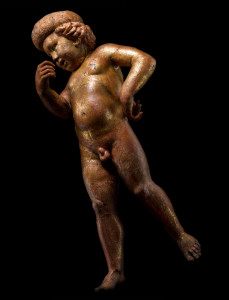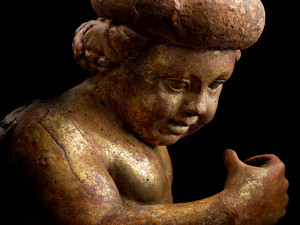NEW YORK CITY — Throughout much of the history of art, sculpture represented the figure standing still, not in action.
Donatello (1386–1446), widely recognized as one of the greatest sculptors ever to have lived, was the first sculptor since antiquity to capture the drama of the figure in mid-action. He changed the course of Western art, in this and in so many other ways, influencing artists not only of his own era, but to the present day.
One of the earliest examples of this change is dramatically represented in the single-work exhibition “Donatello in Motion: A Spiritello Rediscovered,” opening October 30 at Moretti Fine Art in New York. Never before seen in public, “The Spiritello” made by Donatello in the 1430s, originally formed part of an architectural ensemble decorating an interior space, possibly a sacristy in a church or a room in a palace. This ensemble would have featured at least two putti dancing or flying about the top of the room, and likely carrying garlands, or armorial shields.
In the Renaissance, a spiritello (literally a little spirit) was a cherub-like figure that represented the dynamic power of invisible forces such as love or music. It was Donatello himself who largely invented and popularized this type of mythical creature, making the spiritello or putto a standard part of the visual repertoire of Western civilization. “Donatello’s art has a timeless immediacy that makes it ever contemporary — it never grows old or stale and “The Spiritello,” capturing the joyful embodiment of energy, exemplifies the essence of his art. A figure of unbridled liberty of invention and imagination, Donatello’s artistry was always in motion – forward,” said Andrew Butterfield, the Italian Renaissance scholar and art dealer who discovered the Donatello shown at the exhibition.
Of the Donatello sculpture, the New York Times reported, “Mr Butterfield and several other experts he has enlisted now believe the statue is a lost work by Donatello, one of the defining artists of the Renaissance, and a rare example of the artist’s work in wood, making the discovery not only a major addition to Donatello’s surviving corpus, but also to the history of Western sculpture.”
“It is a great honor to have the chance to show a new Donatello, one of the founders of the Renaissance,” says Fabrizio Moretti, founder of Moretti Fine Art. A fully illustrated catalog edited by Andrew Butterfield with essays by three renowned experts on Renaissance art, Francesco Caglioti, David Ekserdjian and Eike Schmidt, recently named the director of the UfFizi, accompanies the exhibition.
The exhibition is on view October 30–November 25 at Moretti Fine Art, 24 East 80th Street, second floor. For more information, www.andrewbutterfield.com.



